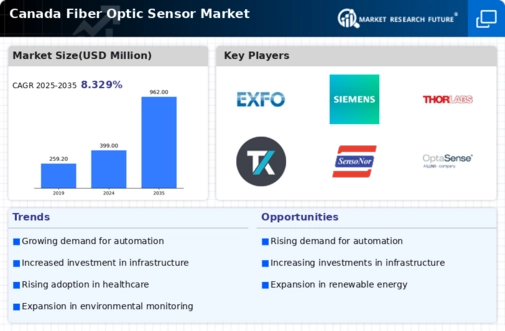Growing Industrial Applications
The fiber optic-sensor market is experiencing a notable surge in demand due to its expanding applications across various industrial sectors in Canada. Industries such as oil and gas, manufacturing, and aerospace are increasingly adopting fiber optic sensors for their ability to provide precise measurements and real-time monitoring. For instance, the oil and gas sector utilizes these sensors for pipeline monitoring, ensuring safety and efficiency. The market is projected to grow at a CAGR of approximately 10% over the next five years, driven by the need for enhanced operational efficiency and safety standards. This trend indicates a robust future for the fiber optic-sensor market, as industries seek innovative solutions to improve their processes and reduce costs.
Advancements in Sensor Technology
Technological advancements in sensor technology are propelling the fiber optic-sensor market forward. Innovations such as improved sensitivity, miniaturization, and enhanced data processing capabilities are making fiber optic sensors more attractive for various applications. These advancements allow for better performance in harsh environments, which is particularly beneficial for industries like mining and construction. The market is projected to expand as companies adopt these cutting-edge technologies to improve their monitoring and control systems. With an expected growth rate of 12% annually, the fiber optic-sensor market is likely to see a proliferation of new applications and enhanced functionalities, catering to the evolving needs of different sectors.
Government Initiatives and Funding
Government initiatives in Canada are playing a pivotal role in the growth of the fiber optic-sensor market. Various funding programs and grants are being introduced to support research and development in advanced sensor technologies. The Canadian government has allocated over $200 million to promote innovation in the technology sector, which includes fiber optic sensors. This financial backing encourages companies to invest in new technologies, thereby enhancing the capabilities and applications of fiber optic sensors. As a result, the market is likely to witness an influx of innovative products and solutions, further solidifying its position in various sectors, including environmental monitoring and structural health assessment.
Rising Demand for Smart Infrastructure
The increasing focus on smart infrastructure in Canada is significantly influencing the fiber optic-sensor market. As cities evolve towards smart technologies, the need for advanced monitoring systems becomes paramount. Fiber optic sensors are integral to smart grids, transportation systems, and smart buildings, providing critical data for efficient management. The market is expected to grow as municipalities invest in smart city initiatives, with an estimated budget of $1.5 billion allocated for infrastructure upgrades in the coming years. This trend suggests that the fiber optic-sensor market will benefit from the integration of these sensors into various smart applications, enhancing operational efficiency and sustainability.
Increased Focus on Safety and Compliance
The fiber optic-sensor market is witnessing a heightened emphasis on safety and compliance across various industries in Canada. Regulatory bodies are imposing stricter safety standards, particularly in sectors such as oil and gas, where monitoring systems are crucial for preventing accidents. Fiber optic sensors offer reliable solutions for detecting hazardous conditions, thereby ensuring compliance with safety regulations. The market is anticipated to grow as companies prioritize safety investments, with an estimated increase in spending on safety technologies projected to reach $500 million by 2026. This focus on safety not only drives demand for fiber optic sensors but also enhances their adoption in critical applications, reinforcing their importance in the market.
















Leave a Comment